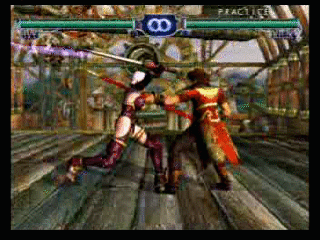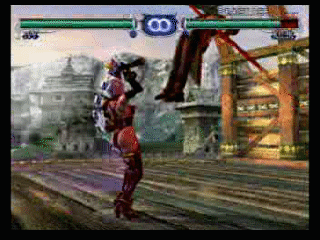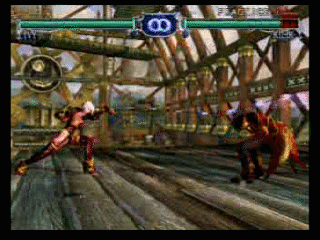Mage
I'll make you submit!
When SCII originally came out, a few guides were posted as extremely helpful pointers on how to get good with Ivy. Recently, I was chatting with Slade and KineticClash in the chatroom and we decided to take a look at one of the guides, made by Kvalsternacka.
I was pretty impressed by the detail it beheld and decided it would probably be good to post them here for people to read and try to get some understanding of SCII Ivy (or regain the knowledge, if you played it in the past) in preparation for the upcoming release of Soulcalibur II HD Online. Now, at the moment, it is unknown whether it will be patched, however we do know that it will be based on the PS2 version.
They all go into to detail about her moves, combos, little tips and tricks, and more so I would urge you to take some notes if you plan on using Ivy in the re-release.
If you are new to Soulcalibur completely, please watch this video and keep this page bookmarked as they both explain the notation in Soulcalibur very well, and even though the video is recorded using Soulcalibur IV, it applies to every Soulcalibur game.
This is Kvalsternacka's original guide for Ivy. It was written in late 2003 and is based upon the Gamecube version but most of the stuff in it still applies to the Playstation 2 and Xbox versions also. Kvalsternacka opens the guide by giving a beginner's introduction to the notation used in the Soulcalibur universe, and then moves on to talk about how Soul Charge affects her moves and then talks about Ivy's ring out options. He then continues to tell us about her "lick" which is her move that is used to grab people out of the air and smack them down onto the floor. Moving on he talks about moves that are not listed in her movelist, her combos, and extra tips and tricks for Ivy. This guide will definitely get you started with Ivy.
This is NikolakakisGr's original guide for Ivy. It was written in early 2003 before Kvalsternacka;'s guide came out and is based upon the Xbox version but as I said about the guide above, most of it will still apply to the Playstation 2 version (which will be used in the remake). He begins by talking about Ivy's story and her profile before moving onto her movelist. He then talks about Ivy's stances in Soulcalibur II and her weapons, after which he talks about different tactics for Ivy. Definitely worth a read for potential Ivy players.
Finally, this is Tyrasibion's original guide for Ivy. It was written just before Kvalsternacka released his guide, late 2003 and was last updated early 2004, and is based upon the Gamecube version of the game. In most aspects it is very similar to Kvalsternacka's guide. It presents Ivy and her story, then it moves on to explain simple notation, not as explicitly as Kvalsternacka, but it explains the simple notation of directional inputs, and then covers her movelist. It then talks about good moves that are recommended to be used by an Ivy player and explains why. The final few paragraphs talk about trivial things about Ivy, such as her signature stage within the game, and her costumes. Although similar to Kvalsternacka's, I would still recommend you read this as it contains pieces of good information that Kvalsternacka missed.
I hope I gave you a good idea of what each guide contains and what it will present to you, happy reading, and after release look out for updates to this thead!
I was pretty impressed by the detail it beheld and decided it would probably be good to post them here for people to read and try to get some understanding of SCII Ivy (or regain the knowledge, if you played it in the past) in preparation for the upcoming release of Soulcalibur II HD Online. Now, at the moment, it is unknown whether it will be patched, however we do know that it will be based on the PS2 version.
They all go into to detail about her moves, combos, little tips and tricks, and more so I would urge you to take some notes if you plan on using Ivy in the re-release.
If you are new to Soulcalibur completely, please watch this video and keep this page bookmarked as they both explain the notation in Soulcalibur very well, and even though the video is recorded using Soulcalibur IV, it applies to every Soulcalibur game.
This is Kvalsternacka's original guide for Ivy. It was written in late 2003 and is based upon the Gamecube version but most of the stuff in it still applies to the Playstation 2 and Xbox versions also. Kvalsternacka opens the guide by giving a beginner's introduction to the notation used in the Soulcalibur universe, and then moves on to talk about how Soul Charge affects her moves and then talks about Ivy's ring out options. He then continues to tell us about her "lick" which is her move that is used to grab people out of the air and smack them down onto the floor. Moving on he talks about moves that are not listed in her movelist, her combos, and extra tips and tricks for Ivy. This guide will definitely get you started with Ivy.
This is NikolakakisGr's original guide for Ivy. It was written in early 2003 before Kvalsternacka;'s guide came out and is based upon the Xbox version but as I said about the guide above, most of it will still apply to the Playstation 2 version (which will be used in the remake). He begins by talking about Ivy's story and her profile before moving onto her movelist. He then talks about Ivy's stances in Soulcalibur II and her weapons, after which he talks about different tactics for Ivy. Definitely worth a read for potential Ivy players.
Finally, this is Tyrasibion's original guide for Ivy. It was written just before Kvalsternacka released his guide, late 2003 and was last updated early 2004, and is based upon the Gamecube version of the game. In most aspects it is very similar to Kvalsternacka's guide. It presents Ivy and her story, then it moves on to explain simple notation, not as explicitly as Kvalsternacka, but it explains the simple notation of directional inputs, and then covers her movelist. It then talks about good moves that are recommended to be used by an Ivy player and explains why. The final few paragraphs talk about trivial things about Ivy, such as her signature stage within the game, and her costumes. Although similar to Kvalsternacka's, I would still recommend you read this as it contains pieces of good information that Kvalsternacka missed.
I hope I gave you a good idea of what each guide contains and what it will present to you, happy reading, and after release look out for updates to this thead!
Last edited:





